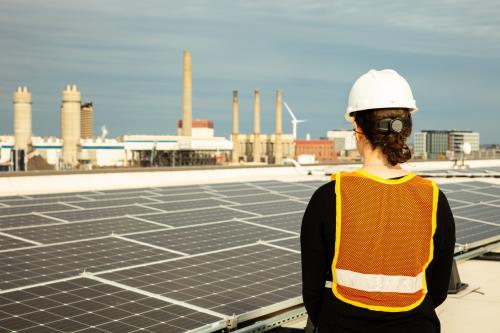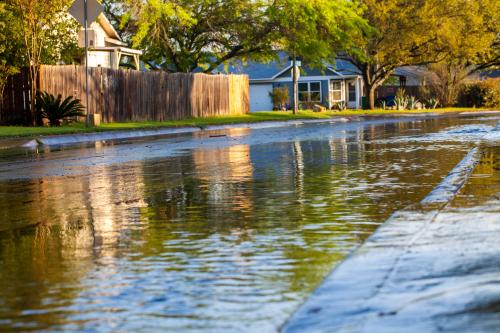Later this year, Congress is set to reauthorize the Federal Aviation Administration (FAA), which opens up the opportunity to modernize and reform the nation’s airports and airlines. While Congress has passed a flurry of unexpected aviation policies in the past few years—including a $25 billion airline bailout and $25 billion in new airport capital spending—FAA reauthorization is the primary legislative process to address long-standing industry issues such as airspace navigation, tax structures, and passenger fees. This year, federal lawmakers should add one more issue to their list: protecting our airports and their passengers from short- and long-term climate threats.
Airports play a central role in our national economy, from expanding our information and tourism industries to connecting people to their loved ones. The problem is that the country’s airports are under threat from a changing climate, including rising sea levels, extreme heat, and other weather-related events. Compounding this problem is the lack of any major policy response, including a lack of federal programs dedicated to building resilience at the country’s commercial service airports. Federal and local leaders must do more to protect these national economic assets.
Lawmakers should use the upcoming FAA reauthorization as an opportunity to align our economic security with our environmental security. First, Congress should incentivize airport authorities to develop resilience plans that will guide how their facilities adapt to emerging climate realities. Second, Congress should launch a pilot program to strengthen existing assets and build resilient infrastructure at a small number of major commercial airports. If adopted, these two programs could start the country on a course to a more dependable and safer aviation system for generations to come.
An outsized share of passengers relies on a relatively small number of airports
America’s commercial aviation system is an essential driver of national economic competitiveness. Even with the emergence of video conferencing and other digital network technologies, businesses still demand face-to-face meetings among clients and colleagues. Moreover, aviation is the lifeblood of the nation’s tourism hubs, as households plan their holidays and leisure trips around flight availability. And demand is robust: After hitting rock bottom during the COVID-19 pandemic, passenger levels are already now close to their 2019 heights.
While commercial aviation benefits every corner of the country, some airports are simply more important than others. Since airline deregulation in 1978, America has increasingly relied on a hub-and-spoke system to move commercial airline passengers across the country and the world. The result is that the country’s 30 busiest airports moved 71% of all passengers in 2019, many of whom only used the airports to transfer to their final destination. In other words, the entire country relies on a relatively small number of airports.
This becomes especially clear when these airports can’t operate at their full capacity. In 2022, major summer and winter holiday storms caused sweeping waves of flight cancellations and stranded travelers. When airports like Atlanta’s Hartsfield-Jackson, Chicago O’Hare, or Phoenix Sky Harbor can’t operate at full strength, the impacts spread like a virus, touching passengers in every corner of the country.
Commercial airports must adapt to new climate realities
America’s commercial airports are essential to a modern economy, but they also are under threat from a changing climate. To keep planes flying on time and to keep everyone safe, airports need their runways to be clear, their skies to be navigable, and their facilities and other equipment to be resilient to the elements, including protections for workers. Yet the past few years have proven that airports can no longer count on all three elements.
One of the biggest concerns relates to geography: Many airports are located alongside bodies of water, yet as sea levels continue to rise and extreme storms increase in frequency, these airports could soon be dealing with chronic flooding. While scenarios vary locally, the contiguous United States is projected to face between 1.03 and 1.71 feet of sea level rise by 2050. Using data from the National Oceanic and Atmospheric Administration’s (NOAA) Sea Level Rise Viewer, we analyzed the potential flooding impacts of up to 2 feet of sea level rise on 145 large, medium, and small hub airports.
The results are deeply concerning. With just 1 foot of sea level rise, four airports will face significant flooding on over 10% of their land. With 2 feet, the count rises to seven airports. Even with just 1 foot of sea level rise, some, such as New York’s LaGuardia Airport and Philadelphia International Airport, will face frequent flooding in low-lying areas, impacting 21% and 13% of their land, respectively. In total, 24 airports will experience some level of flooding with 1 foot of sea level rise; these airports carried 26% of all passengers in 2019.
Beyond flooded airport grounds, flooded runways would have significant impacts on airport operations and safety. Eleven airports—carrying 15% of all 2019 passengers—will experience runway flooding with 1 foot of sea level rise. And other, less visible factors can increase the vulnerability of certain airports to sea level rise. For example, many airports are built on “reclaimed” land—artificial land created by fill material. When combined with rising sea levels and earthquakes, some reclaimed land is vulnerable to “liquefaction” or instability. These airports must develop adaptive strategies that address not just visible flooding but compounding risks as well.
We can see this scenario playing out on two different sides of the country. If sea levels rise by 1 foot by 2050—a conservative scenario—then the runways at San Francisco International Airport and low-lying areas of Fort Lauderdale-Hollywood International Airport in southeastern Florida would see constant flooding. The latter may look safer by comparison, but the shifting baseline of chronic flooding conditions has negative implications for the airport’s ability to weather more severe flooding associated with acute events.
A more immediate threat are extreme weather events. The rising frequency and intensity of superstorms threaten airports in regions more prone to hurricanes, including most of the major coastal airports from Houston to Miami, and up to at least Charleston, S.C. But it’s the more chronic challenges such as high heat days, major rain events, or high winds that can impact almost any airport, inland or coastal. Last summer’s cancellation of flights at London’s Heathrow Airport due to heat-related runway damage serves as a global warning. With extreme weather events growing in frequency, all signs point toward greater threats ahead.
Kick-starting a federal approach to airport resilience
While the environmental threats to commercial airports have risen for decades, the federal government still does not compel airport authorities to harden their assets. There is no requirement that airport authorities draft resilience plans focused on adaptation, which limits their understanding of both individual climate risks and the potential costs to address those risks. The FAA’s Aviation Climate Action Plan recognizes this planning gap: “FAA is considering reinitiating [the Airport Sustainability Planning] program with an emphasis on resilience planning to address climate and extreme weather risks to airports in relation to sustainability.”
Likewise, there is no significant FAA capital program exclusively dedicated to investing in resilient airport infrastructure. Instead, the federal government relies on disaster recovery efforts—if anything at all—after impacts occur. To promote interstate commerce, it’s in the federal government’s best interest to address this policy gap.
The federal policy gap is matched by a general research gap. As Fiona Greer, Jasenka Rakas, and Arpad Horvath note in their analysis of 108 peer-reviewed journal articles, “The resilience of airports to climate change impacts is a significantly under-researched subject.” A lack of recent and overall publications by the National Academies’ aviation research division, the Airport Cooperative Research Program, affirms this finding. This research gap has practical implications too: We simply know too little about the range of needs and costs in the airport adaptation space.
Fortunately, airport authorities and their federal partners have time to devise long-term strategies. We recommend two courses of action, both of which can inform more permanent solutions in the future.
First, Congress should incentivize airport authorities to develop climate resilience plans that will guide how their facilities can adapt to emerging environmental conditions. Much like the resilience-focused planning requirements within the PROTECT and WaterSMART programs (or ongoing adaptation planning underway at the Department of Defense), this new planning program would help airports formally understand their climate threats, possible interventions, and the costs to implement them. The FAA can develop standard guidelines, and the program should be large enough to fund plans at multiple large, medium, and small hub airports. The guidelines should include a standard reporting feature that can inform an FAA database of typical project needs and costs. In the long term, lessons from the initial planning effort can inform a more permanent planning requirement and grant program for all airports who receive FAA Airport Improvement Program awards in the future.
Second, Congress should launch a pilot program at the FAA to build resilient infrastructure at a small number of major commercial airports. With little resilience-focused construction underway at commercial airports, the FAA needs to experiment with different approaches to protecting these national economic assets. We recommend focusing on a mix of climate threats, such as flooding events at one airport and extreme heat at another, and their related interventions. Airports should be selected based on demonstrated climate need and preparedness to invest, including local fiscal resources. In designing the program, legislators and FAA staff can reference the Airport Environmental Mitigation Pilot Program. While many necessary adaptive interventions are likely to be costly (see San Francisco International Airport’s $590 million Shoreline Protection Program), early investment is our best chance to prevent even more expensive service disruptions and disaster recovery efforts in the future. In the long term, Congress and the FAA can use the lessons from the pilot to determine the best size for a more permanent program and the federal aviation taxes that could be secured to fund it.
Combined, these two pilot programs represent a careful first step to hardening the country’s airports. They promise to expand on some of the environmental research efforts already underway across the federal government, such as within the FAA’s Airport Technology Research and Development branch and the Volpe Center. They also promise to create referenceable use cases for other airport authorities looking to protect their assets.
There is a permanent tension between the need for Americans to fly and the threat our airports face from a changing climate. Federal airport resilience programs are critical for keeping the country safe and on the move for decades to come.
The Brookings Institution is committed to quality, independence, and impact.
We are supported by a diverse array of funders. In line with our values and policies, each Brookings publication represents the sole views of its author(s).












Commentary
America’s airports aren’t ready for climate change
March 1, 2023